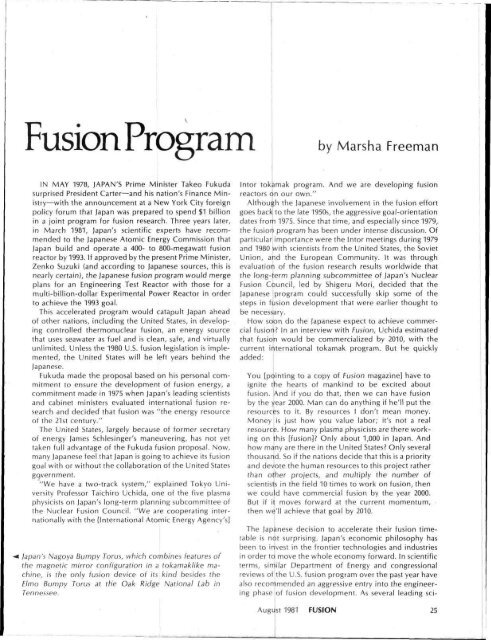Exclusive Interview with Shuttle Pilot Robert Crippen
Exclusive Interview with Shuttle Pilot Robert Crippen
Exclusive Interview with Shuttle Pilot Robert Crippen
You also want an ePaper? Increase the reach of your titles
YUMPU automatically turns print PDFs into web optimized ePapers that Google loves.
Fusion Programby Marsha FIN MAY 1978, JAPAN'S Prime Minister Takeo Fukudasurprised President Carter—and his nation's Finance Ministry—<strong>with</strong>the announcement at a New York City foreignpolicy forum that Japan was prepared to spend $1 billionin a joint program for fusion research. Three years later,in March 1981, Japan's scientific experts have recommendedto the Japanese Atomic Energy Commission thatJapan build and operate a 400- to 800-megawatt fusionreactor by 1993. If approved by the present Prime Minister,Zenko Suzuki (and according to Japanese sources, this isnearly certain), the Japanese fusion program would mergeplans for an Engineering Test Reactor <strong>with</strong> those for amulti-billion-dollar Experimental Power Reactor in orderto achieve the 1993 goal.This accelerated program would catapult Japan aheadof other nations, including the United States, in developingcontrolled thermonuclear fusion, an energy sourcethat uses seawater as fuel and is clean, safe, and virtuallyunlimited. Unless the 1980 U.S. fusion legislation is implemented,the United States will be left years behind theJapanese.Fukuda made the proposal based on his personal commitmentto ensure the development of fusion energy, acommitment made in 1975 when Japan's leading scientistsand cabinet ministers evaluated international fusion researchand decided that fusion was "the energy resourceof the 21st century."The United States, largely because of former secretaryof energy James Schlesinger's maneuvering, has not yettaken full advantage of the Fukuda fusion proposal. Now,many Japanese feel that Japan is going to achieve its fusiongoal <strong>with</strong> or <strong>with</strong>out the collaboration of the United Statesgovernment."We have a two-track system," explained Tokyo UniversityProfessor Taichiro Uchida, one of the five plasmaphysicists on Japan's long-term planning subcommittee ofthe Nuclear Fusion Council. "We are cooperating internationally<strong>with</strong> the [International Atomic Energy Agency's]•* japan's Nagoya Bumpy Torus, which combines features ofthe magnetic mirror configuration in a tokamaklike machine,is the only fusion device of its kind besides theElmo Bumpy Torus at the Oak Ridge National Lab inTennessee.Intor tokamak program. And we are developing fusionreactors on our own."Although the Japanese involvement in the fusion effortgoes back to the late 1950s, the aggressive goal-orientationdates from 1975. Since that time, and especially since 1979,the fusion program has been under intense discussion. Ofparticular importance were the Intor meetings during 1979and 1980 <strong>with</strong> scientists from the United States, the SovietUnion, and the European Community. It was throughevaluation of the fusion research results worldwide thatthe long-term planning subcommittee of Japan's NuclearFusion Council, led by Shigeru Mori, decided that theJapanese program could successfully skip some of thesteps in fusion development that were earlier thought tobe necessary.How soon do the Japanese expect to achieve commercialfusion? In an interview <strong>with</strong> Fusion, Uchida estimatedthat fusion would be commercialized by 2010, <strong>with</strong> thecurrent international tokamak program. But he quicklyadded:You [pointing to a copy of Fusion magazine] have toignite the hearts of mankind to be excited aboutfusion. And if you do that, then we can have fusionby the year 2000. Man can do anything if he'll put theresources to it. By resources I don't mean money.Money is just how you value labor; it's not a realresource. How many plasma physicists are there workingon this [fusion]? Only about 1,000 in Japan. Andhow many are there in the United States? Only severalthousand. So if the nations decide that this is a priorityand devote the human resources to this project ratherthan other projects, and multiply the number ofscientists in the field 10 times to work on fusion, thenwe could have commercial fusion by the year 2000.But if it moves forward at the current momentum,then we'll achieve that goal by 2010.The Japanese decision to accelerate their fusion timetableis not surprising. Japan's economic philosophy hasbeen to invest in the frontier technologies and industriesin order to move the whole economy forward. In scientificterms, similar Department of Energy and congressionalreviews of the U.S. fusion program over the past year havealso recommended an aggressive entry into the engineeringphase of fusion development. As several leading sci-August 1981 FUSION 25
















